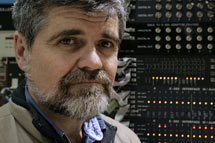
Handy Links
SLAC News Center
SLAC Today
- Subscribe
- Archives: Feb 2006-May 20, 2011
- Archives: May 23, 2011 and later
- Submit Feedback or Story Ideas
- About SLAC Today
SLAC News
Lab News
- Interactions
- Lightsources.org
- ILC NewsLine
- Int'l Science Grid This Week
- Fermilab Today
- Berkeley Lab News
- @brookhaven TODAY
- DOE Pulse
- CERN Courier
- DESY inForm
- US / LHC
SLAC Links
- Emergency
- Safety
- Policy Repository
- Site Entry Form

- Site Maps
- M & O Review
- Computing Status & Calendar
- SLAC Colloquium
- SLACspeak
- SLACspace
- SLAC Logo
- Café Menu
- Flea Market
- Web E-mail
- Marguerite Shuttle
- Discount Commuter Passes
-
Award Reporting Form
- SPIRES
- SciDoc
- Activity Groups
- Library
Stanford
Around the Bay
People: Vladimir Vinetskiy
Vladimir Vinetskiy is becoming an expert in the unknown. That's because, as an electronics engineer in the Structural Molecular Biology division of the Stanford Synchrotron Radiation Lightsource, Vinetskiy makes electronics to order. More often than not, the project in his inbox will look like none of the 600 schematics and printed circuit boards he's designed in the last 12 years.
"It's very intellectually challenging," Vinetskiy said. "You get asked to do things that are not connected to anything you did before."
Vinetskiy and his fellow team members provide the equipment, instruments and expertise that make the SSRL such a powerful tool for scientists. Because SSRL users are working with a nonstop flow of X-rays, they have to be able to adjust their experiments from outside the beamline. Vinetskiy and his technicians make this possible; their electronics command scores of motors within the X-ray beamline, allowing users to change samples, reposition mirrors and detectors, and operate cameras from the outside. Vinetskiy and his technicians built from scratch the banks of electronics currently humming away in seven of SSRL's beamlines, and each piece was tailor-made to user needs.
"We make things specially for this facility," Vinetskiy said. "I have to design what I've never designed before, and if the goals of the experiment change, I have to modify the design. It can be a headache some times, when people ask you to do something you've never seen before, but when they get good results, I'm proud."
According to Vinetskiy, the constant learning his job demands is a large part of its appeal. "I always say that if you get a project that makes you feel like an idiot, that means it's a very good one," he said. "You'll be a lot smarter afterwards!" He has taken a similar approach in his personal life, deftly tackling language and cultural challenges since his 1992 move to the United States from Ukraine with his wife, daughter and elderly parents.
"I had no experience with life here. I had no bank account. I spoke almost no English," Vinetskiy said. "I couldn't even drive a car. And I was already 42 years old."
The first three weeks were especially tough, with 11 family members sharing a single two-bedroom apartment. But four months later, Vinetskiy, who had worked on electronic systems for superconductors in Ukraine, found a job with a Sunnyvale electronics company. He was floored. "I was ready to do any job, I just needed to feed my family," Vinestkiy said. "I didn't expect to do a job in my specialty."
Vinetskiy joined the SLAC team in 1997, and although he's been offered positions in the private sector since, he's never been tempted to leave. "Something inside me always said, stay," he said. "I'd always dreamed of finding an environment like this. Here, it's all about cooperation, exchanging ideas, being kind and ready to help. When someone needs help, nobody ever says no."
—Lauren Schenkman
SLAC Today, March 4, 2009
